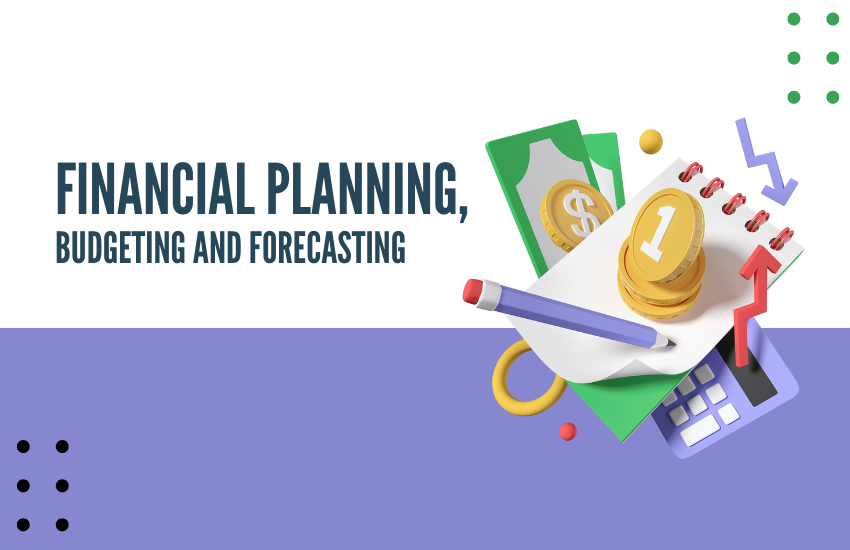Financial Planning, Budgeting and Forecasting

In the modern business landscape, financial planning is not just a necessity—it’s a strategic advantage. At the heart of effective financial planning lie two critical practices: budgeting and forecasting. These processes are more than just number-crunching exercises; they are dynamic tools that empower organizations to anticipate change, allocate resources wisely, and pursue their vision with confidence.
What Are Budgeting and Forecasting?
- Budgeting:
Budgeting is the process of creating a detailed financial plan that outlines expected income and expenditures over a specific period, typically a fiscal year. It acts as a roadmap, guiding spending decisions and setting clear expectations for financial performance. - Forecasting:
Forecasting, by contrast, is the practice of using historical data, current trends, and market analysis to predict future financial outcomes. Unlike a budget, which is usually fixed, forecasts are updated regularly to reflect new information and changing circumstances.
Why Budgeting and Forecasting Matter
- Ensuring Resource Availability
Budgeting ensures that every department and project has the resources it needs to succeed. For example, if a company anticipates launching a new product, budgeting allows for the allocation of funds for research, development, marketing, and distribution. This proactive approach prevents resource shortages that could derail important initiatives. - Setting and Achieving Financial Goals
Budgets transform strategic objectives into measurable financial targets. For instance, if a company’s goal is to increase revenue by 20%, the budget will reflect the necessary investments and expected returns across departments. Regularly comparing actual performance against these targets helps teams stay focused and motivated. - Prioritizing Projects and Initiatives
Not all projects deliver equal value. The budgeting process forces organizations to evaluate potential initiatives based on ROI, alignment with core values, and impact on long-term goals. This ensures that limited resources are channeled into the most promising opportunities. - Attracting Investment and Securing Financing
Investors and lenders want to see evidence of sound financial management. Detailed budgets and credible forecasts demonstrate that an organization understands its business, manages risks, and is prepared for growth. This transparency builds trust and opens doors to new funding opportunities. - Providing Flexibility and Agility
While budgets offer a structured plan, forecasts provide the flexibility to adapt. If market conditions shift unexpectedly—such as a sudden drop in demand or a spike in raw material costs—forecasts can be updated, and budgets can be revised to keep the organization on track.
Maximizing Financial Performance: Best Practices for Budgeting and Forecasting
- Implement Robust Expense Tracking
Effective financial planning starts with accurate data. Use accounting software to monitor every transaction, categorize expenses, and generate real-time reports. This visibility helps identify overspending early and supports informed decision-making. - Leverage Data Analytics
Go beyond basic financial statements. Analyze trends, seasonal patterns, and key performance indicators (KPIs) to uncover insights that drive smarter budgeting and forecasting. For example, a retailer might use historical sales data to anticipate holiday demand and adjust inventory accordingly. - Conduct Regular Reviews and Updates
Financial plans should be living documents. Schedule monthly or quarterly reviews to compare actual results with budgets and forecasts. Analyze variances, understand their causes, and update your plans as needed. This iterative approach keeps your organization agile and responsive. - Foster Cross-Departmental Collaboration
Involve stakeholders from across the organization in the budgeting and forecasting process. Sales, operations, marketing, and finance teams all bring valuable perspectives. Collaboration leads to more accurate assumptions and ensures that plans are grounded in operational reality. - Utilize Scenario Planning
Develop multiple scenarios—best case, worst case, and most likely—to prepare for uncertainty. For example, a manufacturing company might model the financial impact of supply chain disruptions, enabling it to develop contingency plans and minimize risk.
Setting Strategic Goals and Targets in Financial Planning
- Gather and Clean Historical Data
Collect financial records such as income statements, balance sheets, sales figures, and cash flow reports. Clean the data to eliminate errors and ensure consistency. - Analyze Trends and Seasonality
Identify patterns in your data. Are there seasonal spikes in revenue? Do certain expenses increase at specific times of the year? Understanding these trends helps build more accurate forecasts. - Identify Key Metrics
Focus on the metrics that matter most to your business—revenue, gross margin, cash flow, customer acquisition cost, etc. Tailor your analysis to your industry and strategic objectives. - Consider External Influences
Factor in economic trends, industry changes, competitor actions, and regulatory developments. For example, new environmental regulations might increase compliance costs for manufacturers. - Select Appropriate Forecasting Methods
Choose from time series analysis, regression models, or expert judgment based on your data and needs. For instance, a tech company launching a new product might rely on market research and expert input, while a mature business could use historical data trends. - Build and Document Your Forecast
Develop your forecast, clearly documenting assumptions and methodologies. This transparency is crucial for future reviews and stakeholder communication. - Review, Analyze, and Refine
Compare forecasts to actual results regularly. Analyze discrepancies, adjust your assumptions, and refine your models to improve accuracy. - Present and Communicate
Share your forecasts and budgets with stakeholders. Use clear visuals and straightforward explanations to build understanding and buy-in.
Conclusion: Building a Financially Resilient Organization
Budgeting and forecasting are not just about controlling costs—they are about empowering organizations to pursue their ambitions with clarity and confidence. By adopting best practices, leveraging technology, and fostering a culture of continuous improvement, businesses can anticipate challenges, seize opportunities, and achieve sustainable growth.
Whether you’re a startup seeking funding or an established enterprise optimizing operations, mastering the art of budgeting and forecasting is your blueprint for long-term success.
